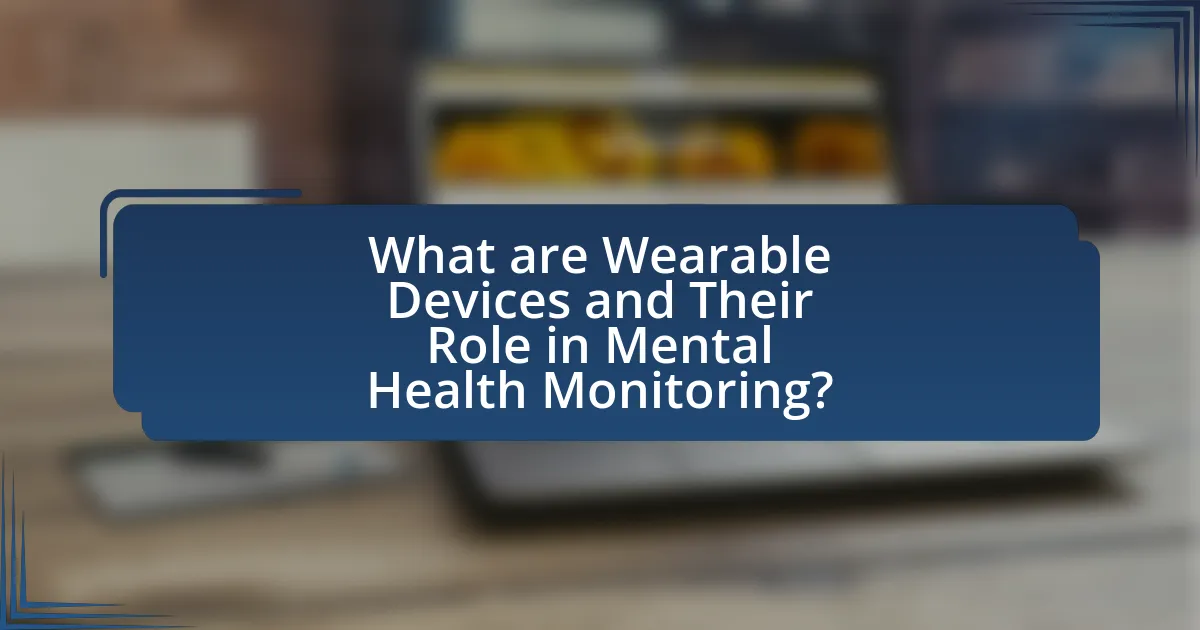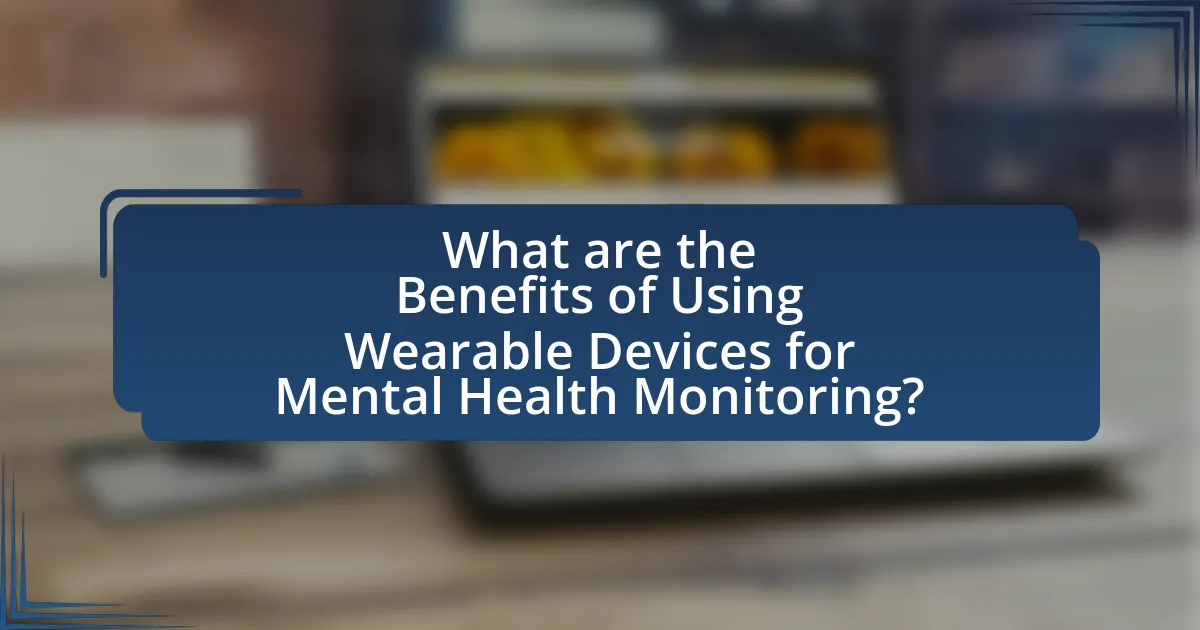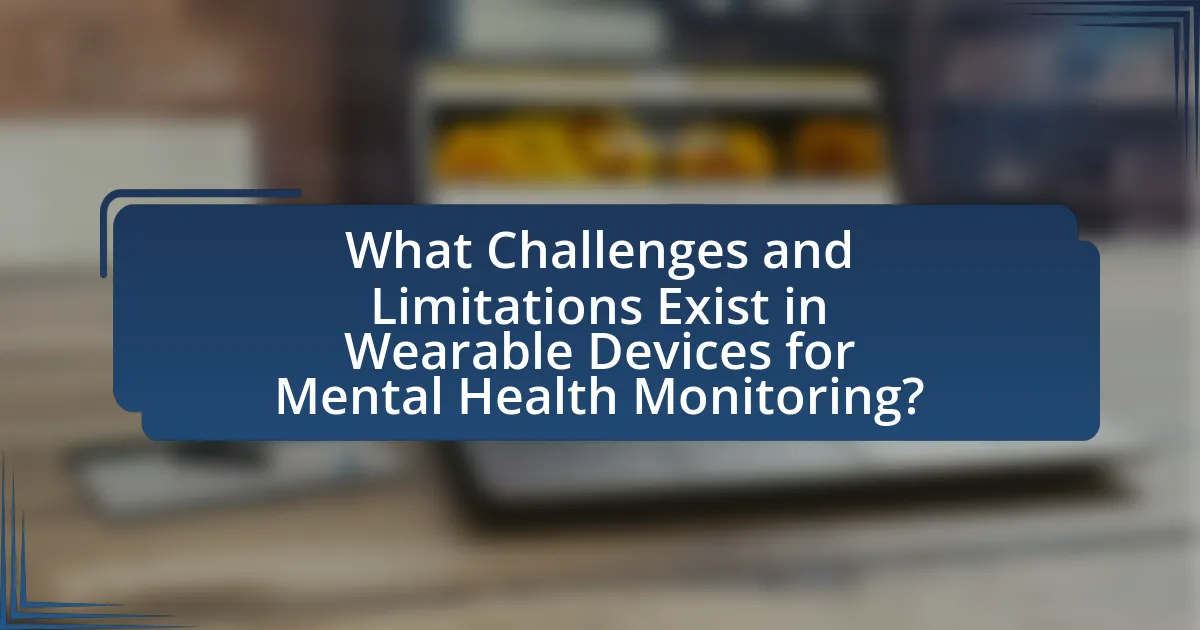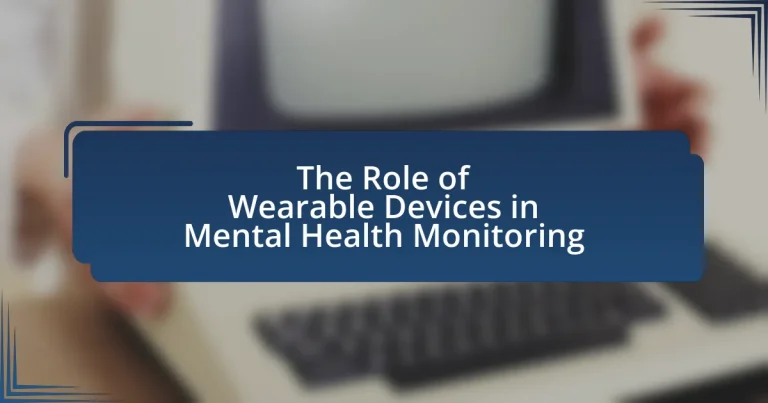Wearable devices are electronic gadgets designed to be worn on the body, playing a crucial role in mental health monitoring by tracking physiological and psychological metrics such as heart rate variability, sleep patterns, and physical activity levels. These devices facilitate early detection of mental health issues, enabling timely interventions and personalized care, which can significantly improve treatment outcomes. The article explores how wearable technology functions in mental health contexts, the types of data collected, the analysis methods used, and the implications for both users and mental health professionals. Additionally, it addresses the challenges and limitations associated with wearable devices, including data accuracy, user compliance, and privacy concerns, while highlighting best practices for effective integration into mental health monitoring.

What are Wearable Devices and Their Role in Mental Health Monitoring?
Wearable devices are electronic gadgets worn on the body that monitor various physiological and psychological parameters. These devices play a significant role in mental health monitoring by tracking metrics such as heart rate variability, sleep patterns, and physical activity levels, which are closely linked to mental well-being. Research indicates that changes in these metrics can signal shifts in mental health status; for instance, a study published in the Journal of Medical Internet Research found that wearable devices can effectively detect anxiety and depression symptoms through continuous monitoring of physiological data. This capability allows for timely interventions and personalized mental health care, enhancing overall treatment outcomes.
How do wearable devices function in the context of mental health?
Wearable devices function in the context of mental health by continuously monitoring physiological and behavioral data to provide insights into an individual’s mental well-being. These devices, such as smartwatches and fitness trackers, collect data on heart rate variability, sleep patterns, and physical activity levels, which are linked to mental health conditions like anxiety and depression. For instance, research published in the Journal of Medical Internet Research indicates that changes in heart rate variability can signal stress levels, allowing users to identify triggers and manage their mental health proactively. Additionally, wearable devices often include features for mindfulness and stress reduction, such as guided breathing exercises, which can further support mental health management.
What types of data do wearable devices collect for mental health monitoring?
Wearable devices collect various types of data for mental health monitoring, including physiological metrics, activity levels, sleep patterns, and biometric data. Physiological metrics such as heart rate variability and skin conductance can indicate stress levels, while activity levels track physical movement and exercise, which are linked to mental well-being. Sleep patterns, monitored through sleep duration and quality, provide insights into mental health, as poor sleep is often associated with mental health issues. Biometric data, including body temperature and blood oxygen levels, can also contribute to understanding an individual’s mental state. These data types are validated by studies showing correlations between physiological changes and mental health conditions, emphasizing the effectiveness of wearables in monitoring mental health.
How is the collected data analyzed to assess mental health?
The collected data from wearable devices is analyzed using various statistical and machine learning techniques to assess mental health. These methods include time-series analysis to track changes in physiological indicators such as heart rate variability and sleep patterns, which are correlated with mental health conditions. For instance, studies have shown that decreased heart rate variability can indicate higher levels of stress and anxiety. Additionally, sentiment analysis of self-reported data collected through mobile applications can provide insights into mood fluctuations. Research has demonstrated that integrating these data points can lead to more accurate assessments of an individual’s mental health status, allowing for timely interventions.
Why is mental health monitoring important?
Mental health monitoring is important because it enables early detection of mental health issues, allowing for timely intervention and support. Regular monitoring can identify changes in mood, behavior, and overall mental well-being, which are critical for preventing the escalation of mental health disorders. Studies show that early intervention can significantly improve outcomes; for instance, research published in the Journal of Clinical Psychiatry indicates that timely treatment can reduce the severity of conditions like depression and anxiety by up to 50%. Therefore, consistent mental health monitoring is essential for maintaining mental wellness and enhancing quality of life.
What are the consequences of untreated mental health issues?
Untreated mental health issues can lead to severe consequences, including increased risk of chronic physical health conditions, impaired daily functioning, and heightened risk of suicide. Research indicates that individuals with untreated mental health disorders are more likely to develop conditions such as heart disease, diabetes, and obesity due to the stress and lifestyle factors associated with mental illness. Additionally, untreated mental health issues can result in significant disruptions in personal relationships, work performance, and overall quality of life. According to the World Health Organization, depression alone is a leading cause of disability worldwide, emphasizing the critical need for timely intervention and treatment.
How can early detection improve mental health outcomes?
Early detection can significantly improve mental health outcomes by enabling timely intervention and treatment. When mental health issues are identified early, individuals can receive appropriate support and resources, which can prevent the escalation of symptoms and reduce the risk of severe mental health crises. Research indicates that early intervention can lead to better long-term outcomes, including reduced hospitalization rates and improved quality of life. For instance, a study published in the journal “Psychological Medicine” found that early treatment of psychosis can lead to a 50% reduction in the risk of relapse. This evidence underscores the importance of early detection in enhancing mental health outcomes.

What are the Benefits of Using Wearable Devices for Mental Health Monitoring?
Wearable devices for mental health monitoring provide real-time data collection, enabling continuous tracking of physiological and psychological indicators. These devices can measure heart rate variability, sleep patterns, and physical activity, which are linked to mental health conditions. For instance, a study published in the Journal of Medical Internet Research found that wearable technology can help identify early signs of anxiety and depression by analyzing changes in these metrics. Additionally, wearables facilitate personalized interventions by allowing users to receive immediate feedback and support, enhancing engagement in mental health management.
How do wearable devices enhance self-awareness in users?
Wearable devices enhance self-awareness in users by providing real-time data on physiological and behavioral metrics, such as heart rate, sleep patterns, and physical activity levels. This continuous feedback allows users to monitor their health and well-being, leading to increased awareness of their emotional and physical states. For instance, a study published in the Journal of Medical Internet Research found that individuals using wearable technology reported improved self-regulation and emotional awareness due to the insights gained from their health data. By translating complex data into understandable metrics, wearable devices empower users to make informed decisions about their lifestyle and mental health, ultimately fostering greater self-awareness.
What features promote mindfulness and emotional regulation?
Features that promote mindfulness and emotional regulation include real-time biofeedback, guided meditation programs, and mood tracking capabilities. Real-time biofeedback allows users to monitor physiological responses such as heart rate variability, which is linked to stress levels and emotional states, enabling individuals to practice mindfulness techniques effectively. Guided meditation programs provide structured sessions that help users cultivate awareness and emotional control, fostering a regular mindfulness practice. Mood tracking capabilities enable users to log their emotional states over time, facilitating self-reflection and awareness of emotional patterns, which is essential for emotional regulation. Research indicates that these features can significantly enhance mental well-being by encouraging consistent mindfulness practices and providing insights into emotional health.
How do wearables facilitate real-time feedback for users?
Wearables facilitate real-time feedback for users by continuously monitoring physiological and behavioral data, such as heart rate, sleep patterns, and activity levels. These devices utilize sensors to collect data and provide immediate insights through connected applications, enabling users to track their mental health indicators in real-time. For instance, a study published in the Journal of Medical Internet Research found that wearables can detect changes in heart rate variability, which is linked to stress levels, allowing users to receive alerts and adjust their behaviors accordingly. This immediate feedback loop empowers users to make informed decisions about their mental health and well-being.
What role do wearable devices play in professional mental health care?
Wearable devices play a significant role in professional mental health care by providing real-time data on physiological and behavioral metrics that can inform treatment decisions. These devices, such as smartwatches and fitness trackers, monitor heart rate, sleep patterns, and physical activity, which are critical indicators of mental health status. Research indicates that continuous monitoring can lead to early detection of mental health issues, allowing for timely interventions. For instance, a study published in the Journal of Medical Internet Research found that wearable technology can improve patient engagement and adherence to treatment plans by providing personalized feedback and insights. This integration of technology into mental health care enhances the ability of professionals to tailor interventions based on objective data, ultimately improving patient outcomes.
How can therapists and clinicians utilize data from wearables?
Therapists and clinicians can utilize data from wearables to monitor patients’ physiological and behavioral patterns in real-time, enhancing treatment personalization. Wearable devices collect data such as heart rate, sleep quality, and physical activity levels, which can provide insights into a patient’s mental health status. For instance, a study published in the Journal of Medical Internet Research found that wearable data can predict depressive episodes by analyzing changes in activity levels and sleep patterns. This data allows clinicians to make informed decisions about treatment adjustments and interventions, ultimately improving patient outcomes.
What are the implications for treatment plans based on wearable data?
Wearable data significantly influences treatment plans by providing real-time insights into patients’ mental health status. This data allows healthcare providers to tailor interventions based on individual patterns of behavior, physiological responses, and emotional states. For instance, studies have shown that continuous monitoring through wearables can lead to early detection of mental health crises, enabling timely adjustments to treatment strategies. Additionally, wearable data can enhance patient engagement by fostering a collaborative approach to care, where patients actively participate in tracking their progress and outcomes. This personalized approach is supported by research indicating that data-driven interventions can improve adherence to treatment and overall mental health outcomes.

What Challenges and Limitations Exist in Wearable Devices for Mental Health Monitoring?
Wearable devices for mental health monitoring face several challenges and limitations, including data accuracy, user compliance, and privacy concerns. Data accuracy is often compromised due to the variability in physiological signals and the algorithms used to interpret them, which can lead to false positives or negatives in mental health assessments. User compliance is another significant challenge, as individuals may not consistently wear the devices or engage with the accompanying applications, resulting in incomplete data. Privacy concerns also pose a limitation, as sensitive mental health data collected by these devices may be vulnerable to breaches or misuse, leading to reluctance among users to adopt such technologies. These challenges hinder the effectiveness and reliability of wearable devices in providing meaningful mental health insights.
What are the privacy concerns associated with wearable devices?
Wearable devices raise significant privacy concerns primarily due to the sensitive personal data they collect, such as health metrics, location information, and behavioral patterns. This data can be vulnerable to unauthorized access, leading to potential misuse by third parties, including hackers and advertisers. A study by the Pew Research Center found that 60% of Americans are concerned about how their personal data is being used by companies, highlighting the widespread apprehension regarding data privacy. Furthermore, many wearable devices lack robust security measures, making them susceptible to data breaches, which can expose users’ private information.
How is user data protected in mental health applications?
User data in mental health applications is protected through a combination of encryption, secure data storage, and compliance with privacy regulations. Encryption ensures that sensitive information, such as personal health data, is converted into a secure format that can only be accessed by authorized users. Secure data storage practices involve using protected servers and cloud services that adhere to industry standards for data security. Compliance with regulations like HIPAA in the United States mandates that mental health applications implement strict safeguards to protect user privacy and confidentiality. These measures collectively enhance the security of user data in mental health applications.
What regulations govern the use of mental health data from wearables?
The use of mental health data from wearables is primarily governed by regulations such as the Health Insurance Portability and Accountability Act (HIPAA) in the United States, which protects patient privacy and data security. HIPAA mandates that any health information, including data collected from wearable devices, must be kept confidential and secure, requiring consent from individuals before their data can be shared. Additionally, the General Data Protection Regulation (GDPR) in the European Union imposes strict guidelines on the processing of personal data, including mental health information, ensuring that individuals have rights over their data and that organizations must obtain explicit consent for data collection and usage. These regulations are crucial for safeguarding sensitive mental health data and ensuring ethical practices in the use of wearable technology.
How accurate are wearable devices in monitoring mental health?
Wearable devices are moderately accurate in monitoring mental health, with studies indicating varying levels of effectiveness depending on the specific metrics being tracked. Research published in the journal “Nature” by Wang et al. (2020) found that wearable devices can reliably measure physiological indicators such as heart rate variability and sleep patterns, which are correlated with mental health states. However, the accuracy of these devices in directly assessing mental health conditions, such as anxiety or depression, is less established and often requires supplementary clinical evaluations for validation.
What factors can affect the reliability of data collected by wearables?
The reliability of data collected by wearables can be affected by several factors, including sensor accuracy, user compliance, environmental conditions, and device calibration. Sensor accuracy is crucial; for instance, studies have shown that heart rate monitors can have a variance of up to 10% depending on the technology used. User compliance, such as wearing the device correctly and consistently, directly impacts data quality; research indicates that inconsistent usage can lead to incomplete or misleading data. Environmental conditions, like temperature and humidity, can also interfere with sensor performance, affecting readings. Lastly, improper calibration of devices can lead to systematic errors in data collection, as evidenced by findings that highlight the importance of regular calibration for maintaining accuracy in wearable devices.
How do wearables compare to traditional mental health assessment methods?
Wearables provide real-time, continuous data on physiological and behavioral metrics, which contrasts with traditional mental health assessment methods that often rely on periodic, subjective evaluations. Traditional methods, such as clinical interviews and standardized questionnaires, can miss fluctuations in mental health status that wearables can capture, such as changes in heart rate variability or sleep patterns. Research indicates that wearables can enhance the accuracy of mental health assessments by providing objective data; for instance, a study published in the Journal of Medical Internet Research found that wearable devices can detect anxiety and depression symptoms with a high degree of accuracy based on physiological signals. This capability allows for more timely interventions compared to traditional methods, which may not reflect immediate changes in a patient’s condition.
What are the best practices for integrating wearable devices into mental health monitoring?
The best practices for integrating wearable devices into mental health monitoring include ensuring data accuracy, prioritizing user privacy, and fostering user engagement. Accurate data collection is crucial, as studies show that reliable metrics improve the effectiveness of mental health interventions. Privacy must be safeguarded, as research indicates that 70% of users are concerned about data security, which can affect their willingness to use such devices. Engaging users through personalized feedback and gamification can enhance adherence to monitoring protocols, with evidence suggesting that increased user interaction leads to better mental health outcomes.




